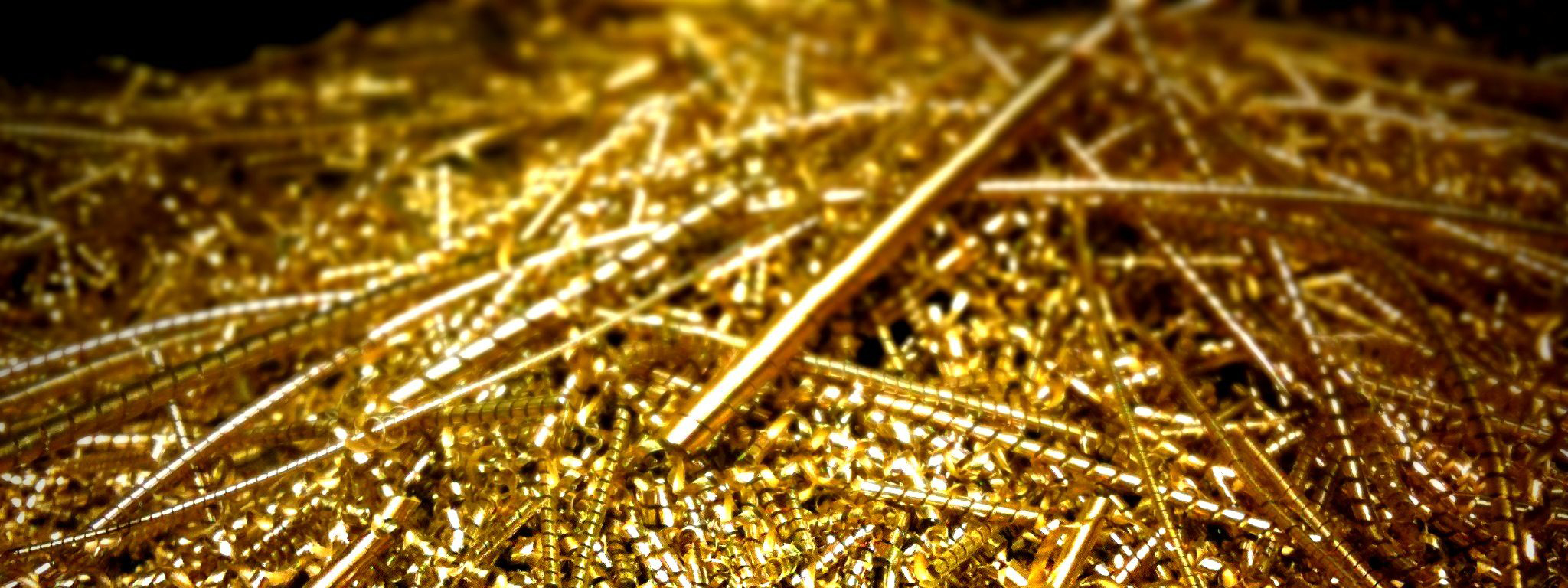This is part of my larger guide to brass instruments:
- Introduction
- Brass Instrument Materials
- What Makes a Brass Instrument a Brass Instrument?
- Brass Instrument Family: Trumpets, Flugels, Cornets
- Brass Instrument Family: French Horns, Trombones, Low Brass
What is Brass?
Brass is an alloy of two metals – zinc which is brittle, and copper which is soft. Depending on which proportions of each metal you combine, a different style of brass is formed. The Online Metals site has a guide to the combinations commonly seen in brass musical instruments:
Gold Brass:
Red Brass:
85% copper, 15% zinc
90% copper, 10% zinc
 Left to right: copper, zinc, brass
Left to right: copper, zinc, brass
What do these different alloys mean in terms of brass instrument playability? Unfortunately, we must start dealing with vague terms – like ‘broader tone’ – which are totally open to interpretation.
Norman’s Musical Instruments in the UK define the qualities of each brass as:
Gold Brass:
Red Brass:
A broader, fuller tone with a good level of projection
A warmer, mellower tone which does not project as well
What does this mean?
- Lower copper content is brighter at the expense of mellowness
- Higher copper content is warmer at the expense of projection
Nickel Silver: The Dark Horse
Some instruments are nickel silver. This is another alloy of copper (60%) and zinc (20%) but it also includes the addition of nickel (20%), which is hard and ductile. The addition of nickel gives a silvery appearance, but it does not polish nicely like silver-plated instrument.
Nickel silver is a tougher alloy in general and is better at preventing corrosion than its nickel-free cousins. It is commonly used in French horns and naturally creates a bright sound.

Nickel Silver Yamaha 668 French Horn
Coatings
There are two main coatings for brass instruments: lacquer and silver plating. This sounds simple, but as you explore the world of brass you will see contention at every turn. Some people go to great lengths to make points you and I would not normally worry about.
Robert Pyle of Harvard University wrote a paper looking at the effects of lacquer and silver plating on horn tone. His conclusions:
- Lacquer dampens the timbre and reduces the strength of high partials in the tone
- Silver plating makes no difference to a horn’s sound than if it were uncoated
Nice job, Robert, but your results have been largely ignored by the industry: lacquer continues to be most popular coating on modern instruments by far.
Lacquer
Lacquer is a clear protective coating. There is a long guide to different types of lacquer (baked epoxy, powder coating, clear-coat paint, nitrocellulose) found here. The most common method used today is ‘baked epoxy’. This coating is applied to a horn and is quite literally baked in an oven to make it fuse properly with the brass.
Importantly, lacquer:
- Keeps the brass underneath shiny
- Helps to prevent minor scratching
However:
- Lacquer can restrict the tonal qualities of the instrument
- Some players will notice the tonal differences
- Some players might say they notice the tonal differences even if they do not
 Lacquered B&S Challenger II Flugel
Lacquered B&S Challenger II Flugel
Silver Plating
Silver plating is a great look on a horn but it can tarnish quite quickly. You can prevent this by regularly wiping your fingerprints off with a microfibre cloth. You can also buy a proper silver polishing cloth or have a technician (e.g. one of us at Vanguard) polish your horn, but this should be done sparingly – annually at most.
Plating an instrument with a thin layer of silver does several things:
- Silver adheres to brass very well and will not flake off like lacquer can.
- It does not stifle the sound of an instrument
However, silver is microscopically porous. This can be a bad thing:
- Silver can absorb the player’s sweat and start corroding the horn between the layers
- Cleaning up messy solder jobs is almost impossible because solder, which is a duller metal, leaks into the pores and adheres to the brass underneath
 Silver Plated Bach 180 Trumpet
Silver Plated Bach 180 Trumpet
Unlacquered
Raw or ‘unlacquered’ instruments have no coating. This means the brass will eventually dull and form a patina. Some people like the uneven, unique look of an unlacquered horn. Other people need their horn to look uniform with other horns in the section.
As discussed earlier, a raw horn may play better that a coated version. You may hear brass players talking about unlacquered instruments being ‘free blowing’. This is high praise indeed.
 Unlacquered (Used) Trumpet at Dillon Music
Unlacquered (Used) Trumpet at Dillon Music
There are other variations to horn coatings, particularly implemented by modern manufacturers. CarolBrass has all kinds of wacky finishes like phosphor bronze, red nickel silver, and amber lacquer.

